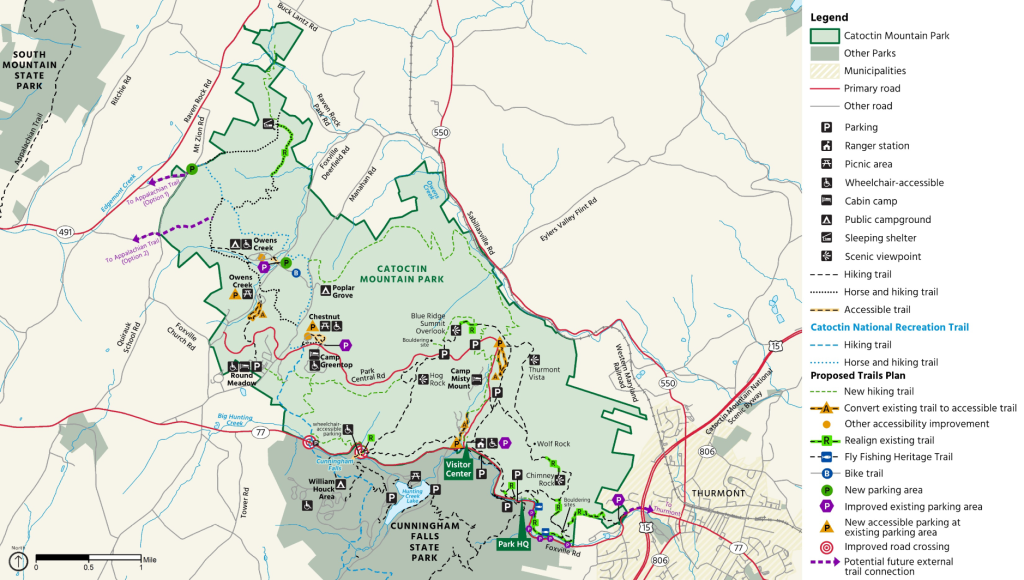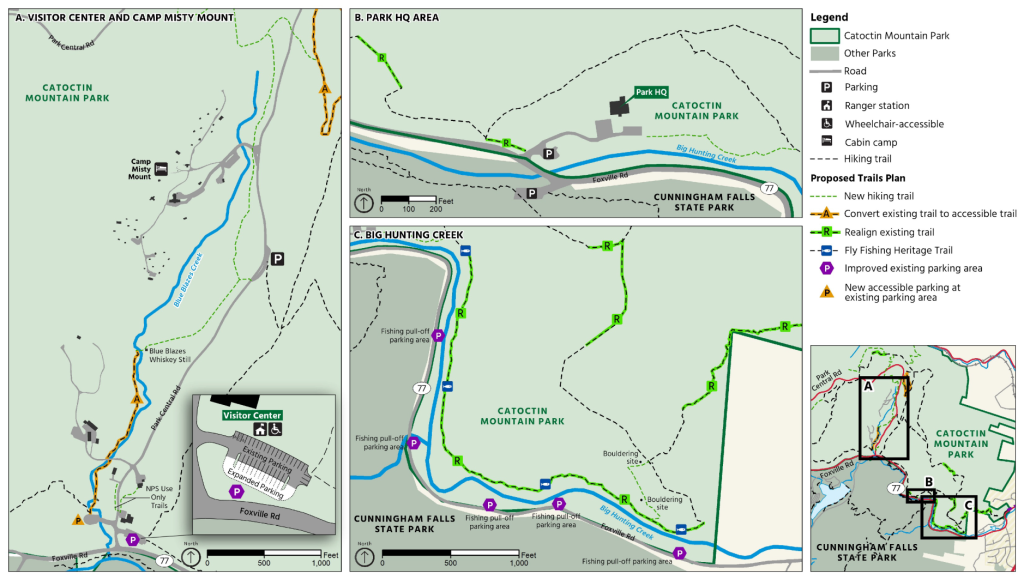Last year, Catoctin Mountain Park began developing a plan to enhance the Park’s trail system and visitor experiences, while balancing recreation with natural and cultural resource protection. Since 2016, when Catoctin Mountain Park restored bouldering access, Mid Atlantic Climbers has been working with National Park Service staff to steward climbing areas and improve the climbing experience in the Park. Through this collaboration, we have discussed climbers’ ideas for adding new trails or rerouting existing trails to increase access to high-quality boulders not currently connected to the trail system.
Earlier this month, the Park opened up a public comment period to gather input on their proposal and environmental assessment for the project (see more information for commenting later on in this post). We were thrilled to see that rock climbing was specifically listed in the assessment’s “Purpose and Need” section – meaning one of the multiple reasons why the Park is proposing changes to the trail system.
The environmental assessment examines two potential options for the Park’s trail system. What they call “Alternative A” would essentially keep the Park’s trail system as it is today, while “Alternative B” is the Park’s proposal for adding and realigning trails, increasing parking opportunities, improving trail crossings of Route 77, and providing new accessible trail amenities. Alternative B includes new and realigned trails to access the Blue Ridge Summit/Hog Rock Parking boulders, Blue Ridge Summit Overlook boulders, and some of the Gateway Trail boulders. This option would also realign 2.7 miles of existing trails to reduce erosion and improve safety, including the Gateway Trail currently used to access bouldering areas in the Park.


In addition, Alternative B would improve signage for trails and bouldering sites in the Park, include routine maintenance on new, realigned, and existing trails, and add more parking opportunities.
Based on climbers’ input, the Park also considered new trails and trail connections that did not make it into their proposal. As we announced at the end of last year, the Park has asked the climbing community to effectively close specific boulders in order to protect important sensitive natural resources. The Park did consider new trails to the General Boulder, Bullfrog Boulder, and Sick Bay Boulder, and offered the following reasons for not including these ideas in their trail system proposal:
“A new trail connection to the General Boulder was dismissed from further consideration because potential trail routes could not avoid steep and unsustainable slopes, which would make constructing and maintaining a sustainable trail not feasible, and the general area around the boulder is steep and rocky, which would create visitor safety concerns and make emergency service responses difficult. A new trail connection to the Bullfrog Boulder and Sick Bay Boulder was dismissed from further consideration due to the location of sensitive resources in the area.”
While the Park’s proposal does not include all of the ideas climbers presented, we are excited for this opportunity to continue collaborating with the Park to improve climbing access. We thank the Park staff for their continued dialogue and for their work to balance recreation and natural resource protection through this trail plan.
The Park wants our input!
The Park is accepting public comments on the trail plan through February 3 on their website, and your input – whether you climb at Catoctin frequently, climb there once or twice a year, or wish to climb there someday – is essential to supporting or improving their proposals for enhanced climbing access. You can submit your feedback by clicking on the “Comment Now” button on the website.
In addition, MAC will be submitting official comments on behalf of our members and volunteers. If you have input or feedback for MAC’s comments, please email jackie@midatlanticclimbers.org by February 1.
What’s next?
Following the end of the comment period, the Park will consider all of the input and select either “Alternative A” (no action) or “Alternative B” (new trail plan). Based on the public comments, the Park may also choose to make changes to the ideas presented in Alternative B before finalizing the plan. Then, if a new trail plan is selected, the Park will get to work! It will be crucial for the local climbing community to be supportive and involved in the development, stewardship and maintenance of climbing access trails and bouldering sites. MAC will continue to keep the climbing community informed as we learn next steps.

Erin Bratcher
I would like to preface my response with the fact that I have not climbed at Catoctin Mountain Park. That being said, my vote is for the Alternative B plan.
The reasoning behind my vote is as follows:
1. Enhancing and developing visitor experiences as the demand for access to public lands grows is an essential duty of the park. Balancing visitor experiences with protection of natural resources and fragile ecosystems may be the most apparent factor when considering construction of new trails/resources and it seems that this plan does just that.
2. Alternative B plan states that there would be an improvement in signage and include routine maintenance on the trails. This is key in ensuring that visitors make a minimal impact because with these improvements people will be less likely to wonder off trail looking for boulders.
3. Improving access to trails and climbing areas and increasing parking options will encourage more people to use this area and to do so with a reduced impact. I appreciate that you all truly thought about the possible adverse impacts and are not including trails to all the boulders on this plan because of the natural resources present in the area.
Jackie Feinberg
Thank you Erin for your input!